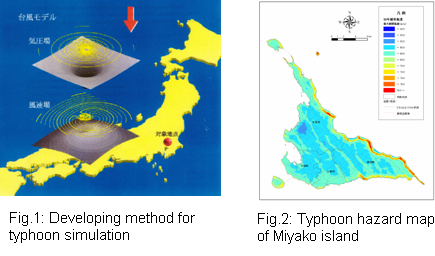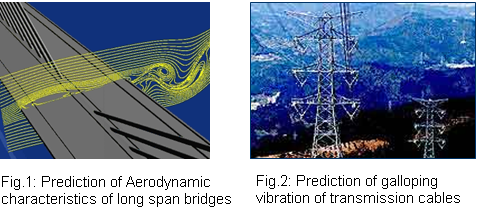Wind Engineering
Numerical local wind prediction using local weather model
This study proposes a model to predict 3D wind characteristics at an arbitrary point with high accuracy, which can be used to improve wind resistance design of civil structures in mountainous regions and for the expanding wind energy facilities. By combining weather forecast technology of meteorology and local wind prediction technology of wind engineering we can predict wind velocity and wind direction at any point in Japan without on site observation.

In this study, the new prediction model called "Dynamical Statistical Downscaling" has been developed. This new model gives a resolution of about 10m, which is about several hundred times more local than the conventional ones. The prediction error of this model is about one-third of the conventional ones, which means several percents. The result of this study is used to improve transmission line's design and maintenance; to create the wind hazard map area along rail way; etc.
A study on design wind velocity based on typhoon simulation
It has been 30 years since the mass production of infrastructure in Japan. The number of strong wind related accident is increasing and this is supposed to be more serious in the future. Consideration of the effect of strong wind on structure's utilization and maintenance is very necessary since the effect of wind in a typhoon to tower, bridges, c are very strong. Especially, there have been reports about the collapse of transmission tower so wind resistance design has become a hot topic. In this study, instead of using the conventional model, which predicts wind velocity based on observation, a new model, which bases on the statistical characteristic of typhoon and the topography of the site, is developed.

A study on prediction of aerodynamic characteristics of structure
In this study a grid computation based system which can calculate aerodynamic characteristic of any structure section with high accuracy is developed. The system can be used to predict wind-induced vibration of structures like long span bridge and ice attached transmission lines. It has been applied to design of the 1600m i.e. second longest center span cable stayed bridge and verified by on site observation. It is also applied to the study of non-steady aerodynamic characteristics of transmission lines with ice attachment to clarify the galloping vibration of transmission lines. The result of this study contributes to the development of study about wind resistance design, galloping prediction and counter method.


